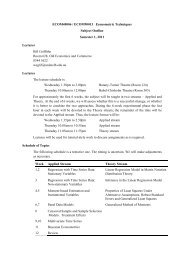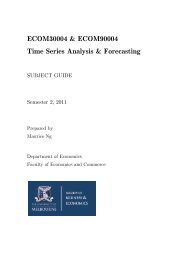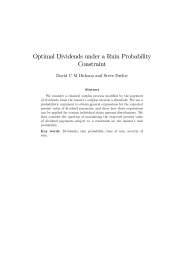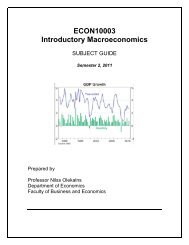A Model of Optimal Corporate Bailouts - Faculty of Business and ...
A Model of Optimal Corporate Bailouts - Faculty of Business and ...
A Model of Optimal Corporate Bailouts - Faculty of Business and ...
Create successful ePaper yourself
Turn your PDF publications into a flip-book with our unique Google optimized e-Paper software.
For low R, below 0.3222, it would not be socially optimal to restart the firm if it has failedeven in the absence <strong>of</strong> tax distortions. Irremediable intrafirm moral-hazard inefficiencies arejust too strong. Thus, government should not intervene in this region.For high R, above 0.8944, it would be privately optimal to restart the firm even withoutgovernment intervention. The red dashed line is the social value if the original manager isfired upon a restart, the blue line if she is kept on. The red line weakly dominates. Withoutintervention, at R ≈ 0.89, the expected social value jumps because the firm suddenly choosesto continue.In the region between 0.3222 <strong>and</strong> 0.8944, not the firm but only the government wouldpotentially want the firm to continue (sv > 0). However, for revenues below 0.7185 if themanager is fired (<strong>and</strong> 0.7305 if not), the distortionary costs <strong>of</strong> taxation are too high to makegovernment intervention useful. The graph shows the two Laffer solutions—the inferior solutionwith a higher tax rate <strong>and</strong> lower effort sufficient to satisfy the budget constraint is dotted. Thus,for revenues above 0.7185, the government should have a policy <strong>of</strong> intervention. This gives thesocial value a jump relative to non-intervention, from a non-intervention value <strong>of</strong> 0.2764 to anintervention value <strong>of</strong> 0.3205. (The function is vertical at its vertex.) 20Figure 2 illustrates the solution variables associated with these parameters. It plots the taxrevenue T 1 , corporate pr<strong>of</strong>its Π (including expected continuation values), wages w 1 , managerialeffort e 1 , <strong>and</strong> managerial utility. Our discussion focuses on the cases in which the manager isfired.Consider the case in which government intervention is just feasible, R ≈ 0.7185.Without government intervention, the firm will shut down. Panel (A) shows that the firmearns pr<strong>of</strong>its <strong>of</strong> Π ≈ 0.065. Panel (B) shows that the manager’s utility is about M ≈ 0.032.Panel (C) shows that the wage is w 1 ≈ 0.359, <strong>and</strong> the managerial effort levels aree 1 = e 2 ≈ 0.180.With government intervention, the firm will restart. Panel (A) shows that a tax <strong>of</strong> T 1 ≈ 0.33on successful firms raises the funds necessary to pay for bailouts (which are 0.035).Panel (B) shows that the firm now expects to earn a pr<strong>of</strong>it <strong>of</strong> 0.02. This is exclusivelyfrom its first-period 10% probability <strong>of</strong> success, because the government expropriates theexisting shareholders in case <strong>of</strong> a bailout. A world with an active government thus leavesthe firm worse <strong>of</strong>f relative to a world without an active government. Panel C shows thatthe bailout also leaves incumbent managers worse <strong>of</strong>f. They are fired in case <strong>of</strong> a bailout.This is because, in comparison to the case without a bailout, their wage is lower. However,if we take into account the welfare <strong>of</strong> the replacement manager (panel D), this is nolonger the case. Finally, Panel (F) shows that government intervention lowers the initialin-equilibrium effort <strong>of</strong> the manager, despite the fact that both owner <strong>and</strong> manager are20 Note that there is also a kink at 0.89, because the owners’ first-order condition changes from optimizingonly their first-period pr<strong>of</strong>its [with government intervention] to optimizing their two-period pr<strong>of</strong>its [because thegovernment now lays <strong>of</strong>f]. Moreover, unlike the government, the government also internalizes the welfare <strong>of</strong> themanager. This in turn changes all solutions.22
















